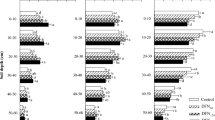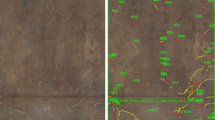Abstract
In perennial forages like alfalfa (Medicago sativa L.), repeated herbage removal may alter root production and mortality which, in turn, could affect deposition of fixed N in soil. Our objective was to determine the extent and patterns of fine-diameter root production and loss during the year of alfalfa stand establishment. The experiment was conducted on a loamy sand soil (Udorthentic Haploboroll) in Minnesota, USA, using horizontally installed minirhizotrons placed directly under the seeded rows at 10, 20, and 40 cm depths in four replicate blocks. We seeded four alfalfa germplasms that differed in N2 fixation capacity and root system architecture: Agate alfalfa, a winter hardy commercially-available cultivar; Ineffective Agate, which is a non-N2-fixing near isoline of Agate; a new germplasm that has few fibrous roots and strong tap-rooted traits; and a new germplasm that has many fibrous roots and a strongly branched root system architecture. Video images collected biweekly throughout the initial growing season were processed using C-MAP-ROOTS software.
More than one-half of all fine roots in the upper 20 cm were produced during the first 7 weeks of growth. Root production was similar among germplasms, except that the highly fibrous, branch-rooted germplasm produced 29% more fine roots at 20 cm than other germplasms. In all germplasms, about 7% of the fine roots at each depth developed into secondarily thickened roots. By the end of the first growing season, greatest fine root mortality had occurred in the uppermost depth (48%), and least occurred at 40 cm (36%). Survival of contemporaneous root cohorts was not related to soil depth in a simple fashion, although all survivorship curves could be described using only five rates of exponential decline. There was a significant reduction in fine root mortality before the first herbage harvest, followed by a pronounced loss (average 22%) of fine roots at the 10- and 20-cm depths in the 2-week period following herbage removal. Median life spans of these early-season cohorts ranged from 58 to 131 days, based on fitted exponential equations. At all depths, fine roots produced in the 4 weeks before harvest (early- to mid-August) tended to have shorter median life spans than early-season cohorts. Similar patterns of fine root mortality did not occur at the second harvest. Germplasms differed in the pattern, but not the ultimate extent, of fine root mortality. Fine root turnover during the first year of alfalfa establishment in this experiment released an estimated 830 kg C ha−1 and 60 kg N ha−1, with no differences due to N2 fixation capacity or root system architecture.
Similar content being viewed by others
References
Aber J D, Melillo J M, Nadelhoffer K J, McClaugherty C A and Pastor J 1985 Fine root turnover in forest ecosystems in relation to quantity and form of nitrogen availability: a comparison of two methods. Oecologia 66, 317–321.
Andrén O, Hansson A-C and Végh K 1993 Barley nutrient uptake, root growth and depth distribution in two soil types in a rhizotron with vertical and horizontal minirhizotrons. Swed. J. Agric. Res. 23, 115–126.
Andrén O, Lindberg T, Boström U, Clarholm M, Hansson A-C, Johansson G, Lagerhöf J, Paustian K, Persson J, Pettersson R, Schnürer J, Sohlenius B and Wivstad M 1990 Organic carbon and nitrogen flows.In Ecology of arable Land - Organisms, Carbon and Nitrogen Cycling. Eds. O Andrén et al. Ecol. Bull. 40, 85–126.
Barnes D K, Heichel G H, Vance C P and Peaden R N 1990 Registration of ‘Ineffective Agate’ and ‘Ineffective Saranac’ non-N2-fixing alfalfa germplasms. Crop Sci. 30, 752–753.
Blumenthal J M and Russelle M P 1996 Subsoil nitrate uptake and symbiotic dinitrogen fixation by alfalfa. Agron. J. 88 (In press).
Boot R G A and Mensink M 1991 The influence of nitrogen availability on growth parameters of fast- and slow-growing perennial grasses.In Plant Root Growth: An Ecological Perspective. Ed. D Atkinson. pp 161–168. Blackwell Scientific Publ., London, UK.
Butler G W, Greenwood R M and Soper K 1959 Effects of shading and defoliation on the turnover of root and nodule tissue of plants ofTrifolium repens, Trifoliun pratense andLotus uliginosus. N.Z. J. Agric. Res. 2, 415–426.
Carlson F A 1925 The effect of soil structure on the character of alfalfa root systems. J. Am. Soc. Agron. 17, 336–345.
Cheng W, Coleman D C and Box J E Jr 1990 Root dynamics, production and distribution in agroecosystems on the Georgia Piedmont using minirhizotrons. J. Appl. Ecol. 27, 592–604.
Dowdy R H, Nater E A and Dolan M S 1995 Quantification of the length and diameter of root segments with public domain software. Commun. Soil Sci. Plant Anal. 26, 459–468.
Dubach M and Russelle M P 1994 Forage legume roots and nodules and their role nitrogen transfer. Agron. J. 86, 259–266.
Fitter A H 1991 Characteristics and functions of root systems.In Plant Roots: The Hidden Half. Eds. Y Waisel, A Eshel and U Kafkafi. pp 3–25. Marcel Dekker, New York, USA.
Grimes D W, Sheesley W R and Wiley P L 1978 Alfalfa root development and shoot regrowth in compact soil of wheel traffic patterns. Agron. J. 70, 955–958.
Hancock J G 1985 Fungal infection of feeder rootlets of alfalfa. Phytopathology 75, 1112–1120.
Hansson A-C, Steen E and Andrén O 1992 Root growth of daily irrigated and fertilized barley investigated with ingrowth cores, soil cores and minirhizotrons. Swed. J. Agric. Res. 22, 141–152.
Heichel G H, Delaney R H and Cralle H T 1985 Carbon assimilation, partitioning, and utilization.In Alfalfa and Alfalfa Improvement. Eds. A A Hanson, D K Barnes and R R Hill Jr. pp 195–228. Agronomy Monograph no. 29. Am. Soc. Agron., Crop Sci. Soc. Am., Soil Sci. Soc. Am., Madison, WI, USA.
Hendershot K L and Volenec J J 1993 Nitrogen pools in taproots ofMedicago sativa L. after defoliation. J. Plant Physiol. 141, 129–135.
Hendrick D L and Pregitzer K S 1993 Patterns of fine root mortality in two sugar maple forests. Nature (London) 361, 59–61.
Hodgkinson K C and Baas Becking H G 1977 Effect of defoliation on root growth of some arid zone perennial plants. Aust. J. Agric. Res. 29, 31–42.
Johnson L D 1992 Morphology and genetics of root types in alfalfa. Ph.D. Thesis, Univ. of Minnesota, St. Paul, USA.
Jones F R 1943 Growth and decay of the transient (noncambial) roots of alfalfa. J. Am. Soc. Agron. 35, 625–634.
Joslin J D and Henderson G S 1987 Organic matter and nutrients associated with fine root turnover in a white oak stand forest. Science 33, 330–346.
Kosola K and Eissenstat D M 1994 the fate of surface roots of citrus seedlings in dry soil. J. Exp. Bot. 45, 1639–1645.
Lamb J F S, Russelle M P, Barnes D K and Vance C P 1995a Develop alfalfa to increase N2 fixation and reduce nitrogen losses to the environment. Clean Water — Clean Environment - 21 st Century, March 5–8, 1995, St. Louis, Missouri. 2, 119–122.
Lamb J F S, Barnes D K, Russelle M P, Vance C P, Heichel G H and Henjum K I 1995b Ineffectively and effectively nodulated alfalfas demonstrate biological nitrogen fixation continues with high nitrogen fertilization. Crop Sci. 35, 153–157.
Lambers H, Szaniawski R K and de Visser R 1983 Respiration for growth, maintenance and ion uptake. An evaluation of concepts, methods, values and their significance. Physiol. Plant. 58, 556–563.
Lory J A, Russelle M P and Heichel G H 1992 Quantification of symbiotically fixed nitrogen in soil surrounding alfalfa roots and nodules. Agron. J. 84, 1033–1040.
Marshall J D and Waring R H 1985 Predicting fine root production and turnover by monitoring root starch and soil temperature. Can. J. For. Res. 15, 791–800.
Mclntosh M S and Miller D A 1981 Genetic and soil moisture effects on the branching-root trait in alfalfa. Crop Sci. 21, 15–18.
McMichael B L, Upchurch D R and Taylor H M 1992 Transparent wall techniques for studying root growth and function in soil. J. Plant Nutr. 15, 753–762.
Meyer W S and Barrs H D 1991 Roots in irrigated clay soils: Measurement techniques and responses to rootzone conditions. Irrig. Sci. 12, 125–134.
Meyerhoff P A 1981 Growth of established alfalfa: relationship to changes in fibrous root mass and response to nitrogen fertilization. M.S. Thesis, Univ. of Calif., Davis, USA.
Meyers L L, Russelle M P and Lamb J F S 1996 Fluridone reveals root elongation differences among alfalfa germplasms. Agron. J. 88, 67–72.
Nadelhoffer K J, Aber J D and Melillo J M 1985 Fine roots, net primary production, and nitrogen availability: A new hypothesis. Ecology 66, 1377–1390.
Nielsen K L, Lynch J P, Jablokow A G and Curtis P S 1994 Carbon cost of root systems: An architectural approach. Plant and Soil 165, 161–169.
Pregitzer K S, Hendrick R L and Fogel R 1993 The demography of fine roots in response to patches of water and nitrogen. New Phytol. 125, 575–580.
Rehm G and Schmitt M 1989 Fertilizing alfalfa in Minnesota. AG-FO-3814. Minn. Ext. Serv., Univ. of Minnesota, St. Paul, USA.
Ryser P and Lambers H 1995 Root and leaf attributes for the performance of fast- and slow-growing grasses at different nutrient supply. Plant and Soil 170, 251–265.
SAS 1990 SAS/STAT user's Guide. Version 6. 4th ed. Vol. 2, GLM-VARCOMP. SAS Inst. Inc. Cary, NC, USA.
Shein E V and Pachepsky Ya A 1995 Influence of root density on the critical soil water potential. Plant and Soil 171, 351–357.
Smith L H and Marten G C 1970 Foliar regrowth of alfalfa utilizing14C-labeled carbohydrates in roots. Crop Sci. 10, 146–150.
Smucker A J M, McBurney S L and Srivastava A K 1982 Quantitative separation of roots from compacted soil profiles by the hydropneumatic elutriation system. Agron. J. 74, 500–503.
Stuteville D L and Erwin D C 1990 Compendium of Alfalfa Diseases. 2nd ed. Am. Phytopath. Press, St. Paul, Minnesota, USA.
Swinnen J, Jan Veen J A and Merckx R 1995 Root decay and turnover of rhizodeposits in field-grown winter wheat and spring barley estimated by14C pulse-labelling. Soil Biol. Biochem. 27, 211–217.
Ta T C and Faris M A 1987 Effects of alfalfa proportions and clipping frequencies on timothy-alfalfa mixtures. II. Nitrogen fixation and transfer. Agron. J. 79, 820–824.
Thicke F E, Russelle M P, Hesterman O B and Sheafer C C 1993 Soil nitrogen mineralization indexes and corn response in crop rotations. Soil Sci. 156, 322–335.
Vogt K A and Bloomfeld J 1991 Tree root turnover and senescence.In Plant Roots: The Hidden Half. Eds. Y Waisel, A Eshel and U Kafkafi. pp 287–306. Marcel Dekker, New York, USA.
Weaver J E 1926 Root Development of Field Crops. MacGraw Hill, New York, USA.
Weisberg S 1985 Applied Linear Regression. 2nd ed. John Wiley and Sons, New York, USA.
Wilson J K 1942 The loss of nodules from legume roots and its significance. J. Am. Soc. Agron. 34, 460–471.
Wright J and Bergsrud F 1991 Irrigation scheduling — checkbook method. AG-FO-1322-G. Minn. Ext. Serv., Univ. of Minnesota, St. Paul, USA.
Author information
Authors and Affiliations
Rights and permissions
About this article
Cite this article
Goins, G.D., Russelle, M.P. Fine root demography in alfalfa (Medicago sativa L.). Plant Soil 185, 281–291 (1996). https://doi.org/10.1007/BF02257534
Issue Date:
DOI: https://doi.org/10.1007/BF02257534




